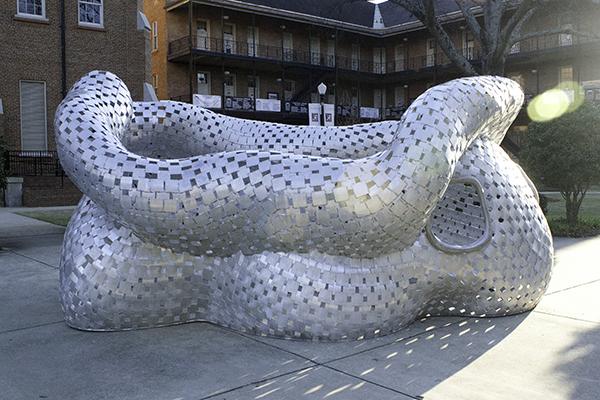Despite being a source of jokes and nicknames, “Argyle” had became something of a staple among University of Alabama students over the past seven years.
Wedderspoon, a UA sculpture professor, said he was shocked that people were upset over the change, which he said was long overdue. He has an agreement with Robert Olin, dean of the College of Arts and Sciences, to switch out the centerpiece every few years.
“The funniest thing about it is the entire time it was over there, I’ve got nothing but crap for it – everyone saying it’s this big phallus,” Wedderspoon said. “I never heard anything positive about it from anyone until it was down, then everyone was, ‘Where is it? We love that thing.’”
“Vessel Series 3,” a wielded tapestry of metal squares, comes from the exhibition “The Quilted Vessel” at the Birmingham Museum of Art. Wedderspoon said he drew inspiration for the openness of the sculpture’s shape and design from nature on both a macro and micro level. He said the sculpture’s square pattern was a reflection of his memories of his mother, a master quilter, sewing fabric.
Tricia McElroy-Faire, associate dean for humanities and fine arts, walks through Woods Quad almost every day on her way to work. She said she was startled when she saw “Argyle” had been replaced but found the new sculpture to be inviting and engaging.
“My unartistic first impression was that it’s shiny,” she said. “The other one had be out there a while. To see part of this series that Craig had done sort of sparkling literally in the sunlight was arresting.”
Wedderspoon said people seemed to be taking to the new sculpture, climbing in and out of it. Several students contacted him about the sculpture, including a student majoring in dance wanting to use it in a choreography performance for class and a student requesting to hang a hammock inside of it, which Wedderspoon said he declined.
“That’s kind of the idea, for that whole sculpture garden to be interactive,” he said. “Once it’s out in the public, you can’t stop the public from interacting with it. Once it’s in the public, it’s in the public.”
McElroy-Faire said she agreed with this idea of interactivity. She often takes her 6-year-old daughter to look at sculptures in the garden. She said her daughter will want to crawl inside the sculpture.
“I kind of want to crawl inside,” she said. “I think there’s something playful about this I really like. It reminds me almost of a playground piece. I think it’s provocative, but for me, that’s what makes it valuable to have out there. If a piece of art provokes art or makes us ask questions or uncomfortable, then I think the artist has achieved something really valuable.”
Bruce Beard, a senior majoring in telecommunication and film, said he is glad to have a change of scenery on his way to class. After four years at the University, he said he was tired of seeing the old sculpture and is excited about the new art piece.
Wedderspoon spent hundreds of hours in his work shop, taking a sabbatical for the Fall 2013 semester. It took him eight months to finish all the works for the exhibit. The most time-consuming part, he said, was sanding the edges and corners of the squares to make sure they weren’t sharp.
The rest of the pieces from the exhibit will be going to North Carolina, and Wedderspoon said he has already found a home for “Argyle.” The sculpture has been on reserve to go to Amy Echols, executive director of Kentuck Museum Association.
McElroy-Faire said she thinks people are puzzled by the new sculpture. She said she’s heard faculty members debate over what the sculpture is and what it means. Wedderspoon said one of his goals is to foster conversation like this.
“My entire goal of making art is that it is a visual philosophy,” he said. “It’s nice when people like what you do, but that doesn’t always happen either. The worst thing that could happen is no response. It’s better to have somebody hate something than for them to feel absolutely nothing.”









